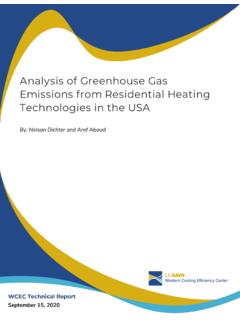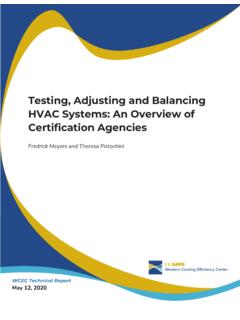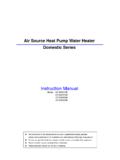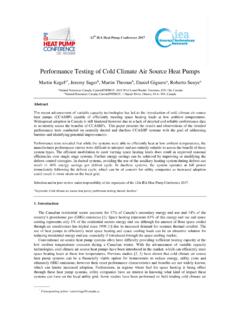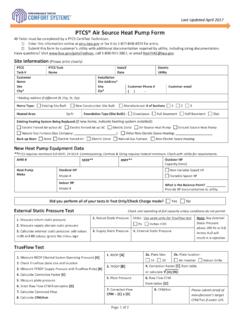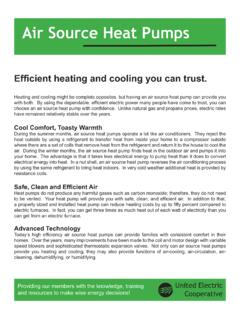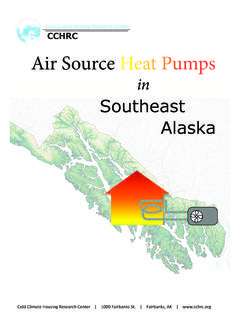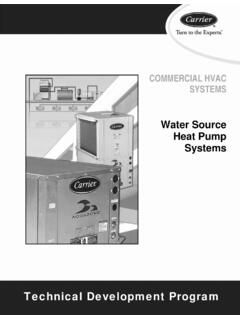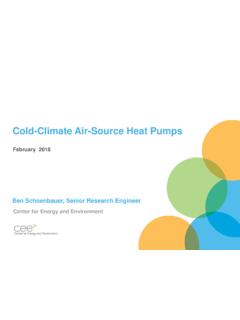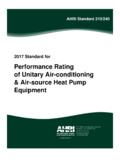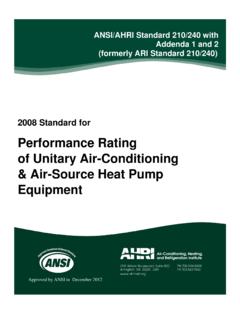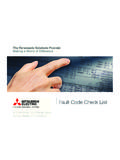Transcription of One Machine for Heating Cooling & Domestic Hot Water ...
1 One Machine for Heating Cooling & Domestic Hot Water : Multi-Function heat Pumps to Enable Zero Net Energy Homes Mark Modera, Jonathan Woolley, David Grupp, University of California, Davis (WCEC) Bill Dakin, Davis Energy Group Michael Koenig, American Honda Motor Company ABSTRACT The evolution of heat -pump technology promises a revolution for residential energy efficiency. While traditional residential mechanical design uses multiple systems and fuels to provide thermal services, the emerging generation of heat -pump technologies can provide Heating , Cooling and Domestic hot Water with a single appliance.
2 These heat pumps operate over a wider temperature range than their predecessors, offer substantial efficiency improvements, and introduce opportunities for waste heat recovery. The Domestic hot Water Heating market is beginning to experience this change as air-source heat -pump Water heaters deliver obvious energy savings over electric-resistance Water heaters; and (arguably) also beat condensing gas-fired systems in terms of source energy consumption and greenhouse gas emissions. However, we anticipate that the current introduction of stand-alone heat -pump Water heaters is only the first step in a transition toward multi-function heat -pumps that can replace conventional air-conditioners, furnaces, and hot Water heaters.
3 The study presented draws from multi-season field measurements of operation and performance for several multi-function heat -pumps. The research assesses the overall efficiency of these systems, and compares the advantages and disadvantages of alternative designs. Our research provides monitored examples of air-source heat pumps, geothermal heat pumps, Water -to- Water systems, and desuperheaters. We also describe the design of the multi-function heat pump at the core of a zero-net-energy demonstration home designed to generate enough electricity to also power the annual drive cycle of an all-electric sedan.
4 The heat -pump in this home is designed to cover all Heating , Cooling and Domestic hot Water needs with no backup. Introduction Traditionally, residential mechanical design has relied on separate systems to provide each specific thermal service including space Heating , space Cooling , and Domestic Water Heating . In California, gas furnaces are generally used for Heating , vapor-compression forced-air systems for Cooling , and gas-fired storage systems for Domestic Water Heating . Reversible heat pumps offer an opportunity to merge these multiple functions into a single Machine .
5 There has been some small but growing application of reversible air-to- air heat pump systems to provide both Heating and Cooling , and geothermal heat pump systems have enjoyed relatively broad application within niche markets. Broader adoption for these systems will require overcoming a variety of technical and financial challenges. The Domestic hot Water Heating industry has recently made significant advances to commercialize stand-alone electric heat -pump storage hot Water heaters. These systems offer obvious benefits compared to electric resistance Water heaters, and can (arguably) also be better than condensing gas-fired systems in terms of source energy consumption and carbon emissions.
6 Since heat pumps are all-electric, they offer the possibility of a move away from on-site combustion for thermal services in residences. This aligns well with goals to reduce non-point source emissions of NOx, and with the budding policy initiatives to advance zero net energy homes as standard practice. As heat pump systems become more common within the industry, we anticipate a movement toward central multi-function heat pumps that provide Heating , Cooling , and Domestic hot Water services in residences. This combination of functions within one Machine promises capital cost savings, efficiency improvements, and opportunities for a significant amount of waste heat recovery.
7 This paper explores a variety of heat pump system architectures that provide multiple functions, and reviews some of the advantages and challenges with each. Detailed field measurements of performance were conducted for three homes that employ different multi-function heat pump arrangements. The results of these efforts motivated the design of a more fully integrated multi-function Water -to- Water heat pump system applied as the core mechanical system in a zero net energy research home recently commissioned in Davis, California.
8 The Davis home is designed to generate enough electricity to offset its annual consumption, plus also cover the annual drive cycle for an all-electric vehicle. Achieving this target drew on a number of innovative features. The mechanical system employs a reversible Water -to- Water heat pump that provides hot and cold Water to hydronic radiant systems for space conditioning, and provides all Domestic hot Water for the home with no backup. When in Cooling mode, the equipment employs a desuperheater to harvest some waste heat for Domestic Water Heating .
9 The heat pump also utilizes an innovative low-cost in-ground heat exchanger that costs a fraction of conventional ground-source approaches, and which recovers heat from greywater. Technical Overview of Multi-Function heat Pump Strategies Multi-function heat pumps employ a reversing valve to allow the indoor (load) heat exchanger and outdoor (source) heat exchanger to swap roles so that the load-side heat exchanger can provide either Heating or Cooling (see Figure 1). For system architectures that can effectively utilize waste heat for some useful purpose (generally pre- Heating for Domestic hot Water ), multi-function heat pumps may include a desuperheater - a heat exchanger located on the discharge side of the compressor before the reversing valve and primary condenser.
10 Figure 1. General schematic of a multi-function heat pump with desuperheater. This reversible refrigerant circuit is central to all multi-function heat pump systems, but it can be applied in a wide variety of ways. Traditionally, residential heat pumps have used a refrigerant-to- air heat exchanger located outdoors and thus use ambient air as the thermal source. Alternatively these systems can use a refrigerant-to- Water heat exchanger, where the Water subsequently exchanges heat with the ground (or a Cooling tower, etc.)
